Uterine vasculature remodeling in human pregnancy involves functional macrochimerism by endothelial colony forming cells of fetal origin
- PMID: 23554274
- PMCID: PMC3813980
- DOI: 10.1002/stem.1385
Uterine vasculature remodeling in human pregnancy involves functional macrochimerism by endothelial colony forming cells of fetal origin
Abstract
The potency of adult-derived circulating progenitor endothelial colony forming cells (ECFCs) is drastically surpassed by their fetal counterparts. Human pregnancy is associated with robust intensification of blood flow and vascular expansion in the uterus, crucial for placental perfusion and fetal supply. Here, we investigate whether fetal ECFCs transmigrate to maternal bloodstream and home to locations of maternal vasculogenesis, primarily the pregnant uterus. In the first instance, endothelial-like cells, originating from mouse fetuses expressing paternal eGFP, were identified within uterine endothelia. Subsequently, LacZ or enhanced green fluorescent protein (eGFP)-labeled human fetal ECFCs, transplanted into immunodeficient (NOD/SCID) fetuses on D15.5 pregnancy, showed similar integration into the mouse uterus by term. Mature endothelial controls (human umbilical vein endothelial cells), similarly introduced, were unequivocally absent. In humans, SRY was detected in 6 of 12 myometrial microvessels obtained from women delivering male babies. The copy number was calculated at 175 [IQR 149-471] fetal cells per millimeter square endothelium, constituting 12.5% of maternal vessel lumina. Cross-sections of similar human vessels, hybridized for Y-chromosome, positively identified endothelial-associated fetal cells. It appears that through ECFC donation, fetuses assist maternal uterine vascular expansion in pregnancy, potentiating placental perfusion and consequently their own fetal supply. In addition to fetal growth, this cellular mechanism holds implications for materno-fetal immune interactions and long-term maternal vascular health.
Keywords: Chimerism; Circulation; Maternal-Fetal Exchange; Neovascularization; Physiologic; Uteroplacenta.
Copyright © 2013 AlphaMed Press.
Figures




Similar articles
-
Prospective surface marker-based isolation and expansion of fetal endothelial colony-forming cells from human term placenta.Stem Cells Transl Med. 2013 Nov;2(11):839-47. doi: 10.5966/sctm.2013-0092. Epub 2013 Oct 8. Stem Cells Transl Med. 2013. PMID: 24106336 Free PMC article.
-
Functional Differences Between Placental Micro- and Macrovascular Endothelial Colony-Forming Cells.Stem Cells Transl Med. 2016 Mar;5(3):291-300. doi: 10.5966/sctm.2014-0162. Epub 2016 Jan 27. Stem Cells Transl Med. 2016. PMID: 26819255 Free PMC article.
-
Bone-marrow-derived endothelial progenitor cells contribute to vasculogenesis of pregnant mouse uterus†.Biol Reprod. 2019 May 1;100(5):1228-1237. doi: 10.1093/biolre/ioy265. Biol Reprod. 2019. PMID: 30601943 Free PMC article.
-
Fetal endothelial colony-forming cells: Possible targets for prevention of the fetal origins of adult diseases.Placenta. 2024 Jan;145:80-88. doi: 10.1016/j.placenta.2023.12.006. Epub 2023 Dec 10. Placenta. 2024. PMID: 38100962 Review.
-
Angiogenesis and vasculogenesis in pregnancy.Eur J Obstet Gynecol Reprod Biol. 2003 Sep 22;110 Suppl 1:S10-8. doi: 10.1016/s0301-2115(03)00168-4. Eur J Obstet Gynecol Reprod Biol. 2003. PMID: 12965086 Review.
Cited by
-
Genomic evidence of Y chromosome microchimerism in the endometrium during endometriosis and in cases of infertility.Reprod Biol Endocrinol. 2019 Feb 13;17(1):22. doi: 10.1186/s12958-019-0465-z. Reprod Biol Endocrinol. 2019. PMID: 30760267 Free PMC article.
-
Modeling renal autoregulation in a hemodynamic, first-trimester gestational model.Physiol Rep. 2022 Oct;10(19):e15484. doi: 10.14814/phy2.15484. Physiol Rep. 2022. PMID: 36200318 Free PMC article.
-
Preeclampsia-Associated Alteration of DNA Methylation in Fetal Endothelial Progenitor Cells.Front Cell Dev Biol. 2019 Mar 19;7:32. doi: 10.3389/fcell.2019.00032. eCollection 2019. Front Cell Dev Biol. 2019. PMID: 30949477 Free PMC article.
-
Endothelial colony-forming cells derived from pregnancies complicated by intrauterine growth restriction are fewer and have reduced vasculogenic capacity.J Clin Endocrinol Metab. 2013 Dec;98(12):4953-60. doi: 10.1210/jc.2013-2580. Epub 2013 Oct 8. J Clin Endocrinol Metab. 2013. PMID: 24106289 Free PMC article.
-
Vitamin D prevents endothelial progenitor cell dysfunction induced by sera from women with preeclampsia or conditioned media from hypoxic placenta.PLoS One. 2014 Jun 2;9(6):e98527. doi: 10.1371/journal.pone.0098527. eCollection 2014. PLoS One. 2014. PMID: 24887145 Free PMC article.
References
-
- Berg CJ, Mackay AP, Qin C, et al. Overview of maternal morbidity during hospitalization for labor and delivery in the United States: 1993–1997 and 2001–2005. Obstet Gynecol. 2009;113:1075–1081. - PubMed
-
- Mikolajczyk RT, Zhang J, Betran AP, et al. A global reference for fetal-weight and birthweight percentiles. Lancet. 2011;377:1855–1861. - PubMed
-
- Romo A, Carceller R, Tobajas J. Intrauterine growth retardation (IUGR): Epidemiology and etiology. Pediatr Endocrinol Rev. 2009;6(suppl 3):332–336. - PubMed
-
- Barker DJ, Osmond C, Forsen TJ, et al. Trajectories of growth among children who have coronary events as adults. N Engl J Med. 2005;353:1802–1809. - PubMed
Publication types
MeSH terms
Grants and funding
LinkOut - more resources
Full Text Sources
Other Literature Sources
Medical

